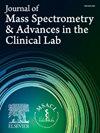Serum peptides as candidate biomarkers for relapsing polychondritis
IF 3.4
4区 医学
Q2 MEDICAL LABORATORY TECHNOLOGY
Journal of Mass Spectrometry and Advances in the Clinical Lab
Pub Date : 2025-04-30
DOI:10.1016/j.jmsacl.2025.04.001
引用次数: 0
Abstract
Introduction
Relapsing polychondritis (RP) is an intractable disease characterized by recurrent inflammation of cartilaginous tissue throughout the body. It is difficult to accurately diagnose RP, and no useful biomarkers have yet been identified.
Objectives
We analyzed serum peptide profiles to identify novel candidate biomarkers for RP.
Methods
Thirty-seven patients with RP, 42 patients with rheumatoid arthritis (RA), and 35 healthy control (HC) subjects were divided into training and testing sets. Seven patients demonstrating granulomatosis with polyangiitis (GPA) were used for validation. The ion intensity of serum peptides was comprehensively measured by matrix-assisted laser desorption/ionization time-of-flight/time-of-flight mass spectrometry and applied to a supervised multivariate analysis. Peptides of interest were analyzed by liquid chromatography-tandem mass spectrometry.
Results
In the training set, models developed based on 11 (RP/HC-11P model), 9 (RP/RA-9P model), and 14 (RP/nonRP-14P model) peptides, out of 160 peptides detected were able to completely discriminate the RP group from the HC, RA, and nonRP (HC + RA) groups. Almost all of the 15 identified discriminatory peptides comprising these models were fragments of proteins associated with coagulation. Four models, each consisting of 4 out of 10 identified peptides of the RP/nonRP-14P model (models RP/nonRP-4P-2, -10, -11, and -38), provided ≥ 70.0 % sensitivity and specificity when applied to the validation set (the testing set and the GPA group) (AUROC, 0.779–0.815). Notably, the RP/nonRP-4P-2 model provided 83.3 % sensitivity and 71.7 % specificity in the validation set (AUROC, 0.802).
Conclusions
Serum peptides are useful as candidate biomarkers for discriminating RP and may be involved in the pathophysiology of RP.
血清多肽作为复发性多软骨炎的候选生物标志物
复发性多软骨炎(RP)是一种以全身软骨组织反复发炎为特征的顽固性疾病。RP很难准确诊断,目前还没有发现有用的生物标志物。目的分析血清肽谱,以确定RP的新的候选生物标志物。方法将37例RP患者、42例类风湿关节炎(RA)患者和35例健康对照(HC)患者分为训练组和测试组。7例肉芽肿合并多血管炎(GPA)患者被用于验证。采用基质辅助激光解吸/电离飞行时间/飞行时间质谱法综合测量血清多肽的离子强度,并应用于监督多变量分析。目的肽通过液相色谱-串联质谱分析。结果基于11个(RP/HC- 11p模型)、9个(RP/RA- 9p模型)和14个(RP/非RP- 14p模型)建立的模型,在160个检测到的肽中,RP组能够完全区分HC组、RA组和非RP组(HC + RA)。几乎所有组成这些模型的15种鉴定的歧视性肽都是与凝血相关的蛋白质片段。四个模型,每个模型由RP/nonRP-14P模型(模型RP/nonRP-4P-2, -10, -11和-38)的10个鉴定肽中的4个组成,在应用于验证集(测试集和GPA组)时提供≥70.0%的灵敏度和特异性(AUROC, 0.779-0.815)。值得注意的是,RP/nonRP-4P-2模型在验证集中提供了83.3%的灵敏度和71.7%的特异性(AUROC, 0.802)。结论血清肽可作为鉴别RP的候选生物标志物,并可能参与RP的病理生理过程。
本文章由计算机程序翻译,如有差异,请以英文原文为准。
求助全文
约1分钟内获得全文
求助全文
来源期刊

Journal of Mass Spectrometry and Advances in the Clinical Lab
Health Professions-Medical Laboratory Technology
CiteScore
4.30
自引率
18.20%
发文量
41
审稿时长
81 days
 求助内容:
求助内容: 应助结果提醒方式:
应助结果提醒方式:


